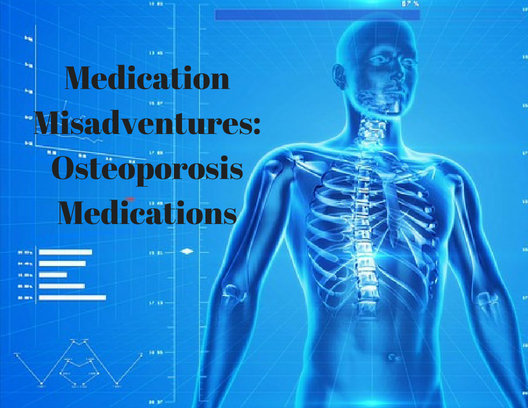There are numerous osteoporosis medications that can be used and I’ve seen a ton of patient mistakes with these medications. Managing osteoporosis is like many other chronic diseases in that the medication helps prevent really bad things from happening. When medications have preventative effects versus immediate effects, patient adherence can often be compromised. Because patients on these medications don’t “feel” any benefit, it is often hard encourage them to continue to take their osteoporosis medications. Here’s a few common mistakes I’ve seen in my practice.
- The bisphosphonates are the most common osteoporosis medication at this time. I’ve had numerous patients take these medications with other medications, food, and different drinks other than plain water.
- The second pearl with bisphosphonates is the fear of osteonecrosis. This is extremely rare, but there are risk factors that may put patients at a higher risk. It is important to ease patient fears of osteonecrosis, but also relay the important benefits of treatment. A hip fracture can be devastating and the medication while having possible side effects can be extremely beneficial.
- Miacalcin nasal spray is a medication I see on occasion. It is significantly more expensive than bisphosphonates which is one of the reasons why it isn’t used first line. You will see this medication used in patients with compression fractures. You have to remember to prime this nasal spray and recognize the dosing on this medication as well. Only 1 spray per day in alternating nostrils is typically recommended. Keeping the device stored upright will also help keep it primed and the dose ready to go. It also requires refrigeration when not being used. I’ve seen all of these mistakes with patients.
- I’ve had numerous patients have a hard time remembering to take their osteoporosis medications (usually bisphosphonates) because they are often dosed at an unusual interval. These drugs are typically dosed on a weekly basis. Ensuring that patients have a good system in place and checking dispensing pharmacy records can really be of assistance in making sure our patients are staying adherent.
- Inadequate calcium and vitamin D intake. This is something that patients need to be aware of and we should assess. I know this can sometimes slip through the cracks in patients who are already on a lot of medications.
Here’s an interesting case from the past on a very serious side effect with Evista.



0 Comments
Trackbacks/Pingbacks